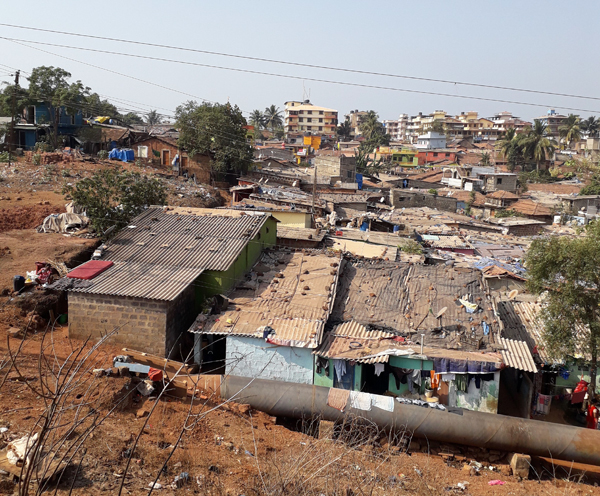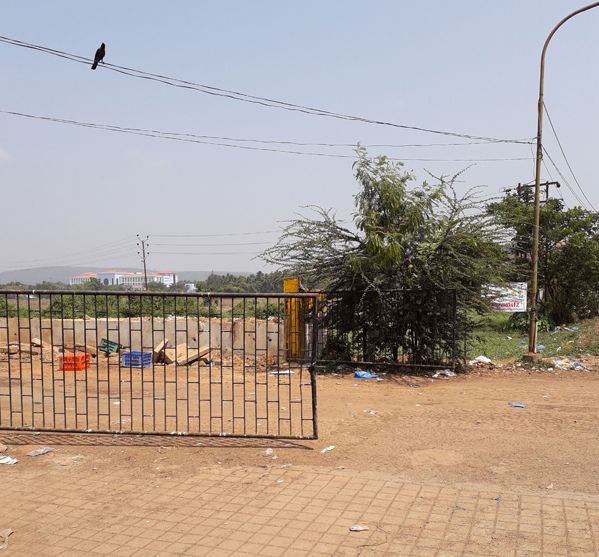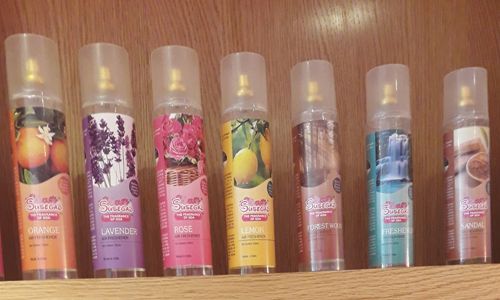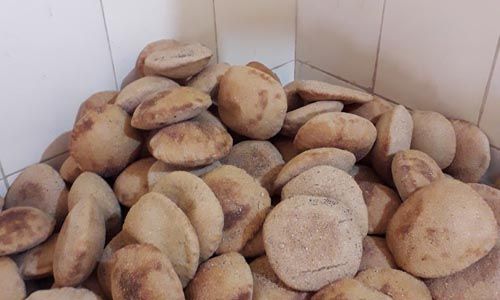Goa’s slum population increased 81% over a decade. At 1.8%, its slum to total population is higher than 6 larger states. In 2017, a study of 14 slums showed that the largest number of migrants came from Karnataka, then UP, Jharkhand and Maharashtra. Residents of Goa’s slums have a decent living and also own cars, taxis, small/big trucks, etc. Maulana denies any political patronage, but how else can a migrant and novice in the business control the entire fish trade in south Goa?
April 9, 2019
Lionel Messias
From Zero slums once, now exclusive slums
It happened that the MLA Damodar Naik asked for the names, addresses and joining date of all workers employed by the Cipla (Goa) group companies in the Goa Assembly late in 2007. The then chief Minister, Digambar Kamat - perennial Margao MLA - who has the body language of a dead frog; replied: “Details such as names etc are not maintained by government.” Einstein could not have been cleverer. In February 2019 the Congress party made him its election campaign manager. Imagine how this could turn out!
It also happens that he was the chief supporter of the Moti Dongor slum in Margao, where migrant votes currently estimated at 3,000 can determine the winnability of the Margao MLA. Moti Dongor has tarred roads, electricity, piped water, a city bus service, school even; all provided at tax payers’ cost. Around the year 2000, the state government made sure that the district administration officials went there to facilitate the issue of ration cards to the slum dwellers, who to a large extent are Muslims.
Goa’s slum population increased 81% over a decade, the 2017-18 Goa Economic Survey (GES) revealed. Its percentage of slum population to total population at 1.8% is significantly higher than six larger states, including Arunachal Pradesh, Himachal Pradesh, Jharkhand, Bihar, Assam and Kerala. Ironically, ‘total population’ in the survey would include non-Goans (long settled in Goa) who are not slum dwellers or migrants. The slum population is concentrated in Margao (10% of the slum population), Mormugao (90%) and Ponda (10%). Other slums like the one in Karaswada in Mapusa, one of Goa’s largest concentrations of slum dwellers does not find mention in the survey.  As does the vast slum area (see above picture) surrounding the Zuari Agro Chemicals factory in Sancoale (a.k.a. Birla or Shantinagar or Zuarinagar) which if a survey was done could possibly turn the GES individual slum stats on its head.
As does the vast slum area (see above picture) surrounding the Zuari Agro Chemicals factory in Sancoale (a.k.a. Birla or Shantinagar or Zuarinagar) which if a survey was done could possibly turn the GES individual slum stats on its head.
Slums Are Vote Banks
In fact, slums like Shantinagar, the Chimbel slum, and Karaswada etc have come under scrutiny after they emerged as game changers in electoral politics, especially to neutralize the ethnic Goan vote.
Four months into 2017 after a provocative statement made by a cabinet minister in the BJP-led coalition Government against Lamanis in Goa, Chief Minister Manohar Parrikar announced his government would build houses for migrants and slum dwellers of Zuarinagar. Less than a year later the Goa Rehabilitation Board issued a tender to survey the slum areas in Zuarinagar, Chimbel, Camrabhat and Porvorim. In mid-2017, a study of 14 slums showed that the largest number of migrants came from Karnataka, mainly from the districts of Gadag, Vijayapura, Belgaum, Bagalkot, Haveri and Dharwad. The majority were Lamanis. Interestingly, the Sarpanch of the Sancoale Village Panchayat is Girish Pillai and one of its panch members is Govind Lamani.
The second largest group is from Uttar Pradesh, followed by Jharkhand and Maharashtra.
Slumming Out In Style
It’s not a recent discovery that migrants especially Lamanis are well off (in many ways better off than some Goans), and are greedier than what was expected of them having come to Goa ‘just-to-get-a-job.’ It had a beginning a decade ago. Goa’s urban slums, except for their dirty exterior are actually shantytowns, with not just decent living conditions inside each home; the residents own cars, taxis, small/big trucks, medium-sized vans to laptops, mobiles and landline phone connections. Yet their vote bank power gets them whatever they demand. Proof: On March 2, 2019 a 12-seater Sulabh Shouchalaya Complex was inaugurated at Lamani colony, Zuarinagar which falls under the Sancoale VP. Strangely, one of the VIPs invited was the Chief Operating Officer of Zuari Agro Chemicals Ltd., Nitin Kantak.
As far back as the 2011 Goa Census, of the 4,846 urban slum households identified, over 70% had televisions, mobiles and bank accounts. Today LPG cooking gas, television and internet connections are passe. Most of these slum-dwellers live in areas of Ponda, Margao and Mormugao.
Of Ganglords And Crime
Less than 5 kms from Panjim, a slum called Indranagar, is different from any other in Goa, growing in size as well as notoriety because of ganglords like Mehboob Mulla Shah alias Bichhu, Joaquim Pereira alias Bhageera and Ashpak Bhengre. When the National Investigation Agency recovered bomb-making equipment from a house in Anjuna, where Yasin Bhatkal, the banned co-founder of the terror group Indian Mujahideen lived in 2011-12; Chimbel was also on their itinerary. In June last year, after a fight between gangs from Merces and Chimbel, police arrested eight gangsters. Of the 20-odd gangsters involved, nearly all were Muslims.
A Fish Mafia, Gate and A Wall!
In April, 2018, former minister Francisco Pacheco, accused the Town and Country Planning (TCP) Minister Vijai Sardesai of “handing over” the Margao wholesale fish market in Madel, Margao, controlled by the South Goa Planning Development Authority (SGPDA) to migrants; he said it was originally established to help Goan fishermen. “80% of the market is taken over by migrants who occupy the market’s well illuminated prime area, while Goans occupy 20% on the periphery that is in darkness. The entire fish trade is controlled by four migrants.” The SGPDA falls under the TCP minister which means that Vijai Sardesai is the decision maker in SGPDA matters.
Their names he said were: Ibrahim Maulana, Abubhakar, Sultan and a person whose initials he gave as B M. “Migrants bring fish from outside Goa after midnight in trucks, while Goan ramponkars are forced to wait outside the market.” (Lead picture caption:SPGDA market, for non-Goans only) The gist of what he meant was that migrant-controlled out-of-state fish trucks are allotted prime space inside the market, while the traditional Goan Ramponkar is forced to remain outside.

Maulana’s LoC (Line of Control) in Madel
Whereas previously any fish vendor could enter the wholesale market, Goan fishermen claim the Vijai Sardesai-controlled SGPDA market’s decision to build a wall around south Goa’s only wholesale market, was to specifically keep Goan fishermen out. Proof they say is the fact the market wall and gate were built much later.
Goan Fishermen Locked Out
Goan fishermen kept out of the market are forced to sell their catch at half or a quarter of the selling rates inside the market; and if they can’t sell all of it, Maulana’s agents buy the unsold catch at even lower rates and preserve it in his cold storages. Many of his agents are also known to own cold storages. Maulana also leads the Margao Wholesale Fish Market Association once controlled by Goans, but were ousted when the wholesale market was shifted to Madel; completing the Sardesai-Maulana control over virtually all of south Goa’s fish industry. He also owns a fish meal plant. Maulana denies any political patronage which begs the question, how can a migrant and novice in the business control the entire fish trade in south Goa without political patronage? Sardesai denies knowing him. Both of course sing their song from the same song book.
Vicious Circle
The fish mafia was first started by Maulana’s father, Mamuji. His vice-like grip began when he started advancing cash to small fishermen on the condition they sold the crab and fish catch to him at lower rates. He next took his money lending to the trawler owners who were already under financial pressure from bank loans taken to buy trawlers; had a seasonal cash requirement to pay their crew - all migrants who demand and are paid advance money of Rs 30,00,000 (earlier Rs 5,00,000-10,00,000). The vicious circle for the Goan, always at the receiving end, does not end here.
Maulana’s father Mamuji loaned these trawler owners money on condition he was sold all the prime catch, especially Solar prawns, at lower rates. Worse was to come. Insisting on settling his dues only at the end of the financial year, Mamuji it is said, manipulated his figures resulting in the trawler owners ending up with a carry-over debt into the next financial year. This vicious debt cycle destroyed many trawler owners.
Goan Tolerance Limitless
The capacity of the Goan to endure even his religion being desecrated is best described by a March 2017 incident when two BITS Pilani students, Sanny Agrawal and Bhojraj Sikarwar, went to the Our Lady of Snows Church in Rachol, received the Holy Communion, but did not swallow it. Instead one of them in a moment of sheer insanity threw the Host on the ground, stamped on it and covered it in mud. One of the students even took a picture of the Host with his mobile. The parish priest Fr Eremito Rebello said afterwards, “I have not registered a criminal complaint. If we do so, they would be dismissed from the institution and their careers ruined.”
Next: (Goa feels the heat of migrant crime, tricks)



